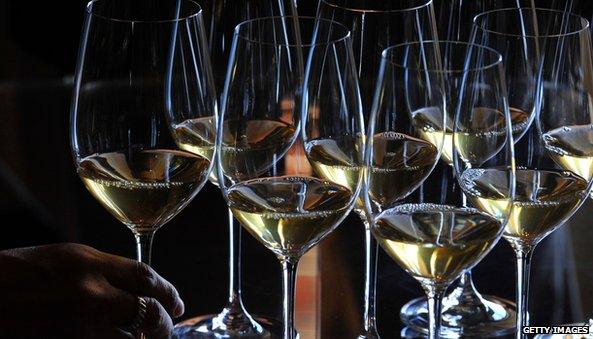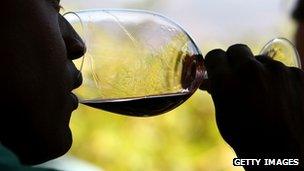Cheers! How drones are helping the wine industry
- Published

Technology is being used to find the optimum areas to grow grapes for the best tasting wine
Unmanned aircraft, satellite mapping and ground sensors controlled by tablet computers - not 21st century espionage but 21st century wine making.
In recent years producers of new world wines have been particularly enthusiastic about embracing what's known as "precision viticulture" according to David Green, a geography professor at the University of Aberdeen who specialises in the subject.
Precision viticulture (PV) is the gathering of all sorts of data about a vineyard, from sunny spots to soil humidity, which is then mapped and analysed in order to grow the best grapes possible on the optimum parts of the site.
"Most precision viticulture originated in America and Australia," said Prof Green.
"Commercial vineyards have a lot more money and the vineyards are that much bigger. In France the process is still very traditional. We have been a bit slower in the UK... the wine industry in Britain started out very much as a hobby-type approach."
The first step is to get aerial images of the entire vineyard. When Prof Green began his work on PV in the 1980s, model aeroplanes were being fitted with a camera and flown overhead to gather the photography.
'Quite hard'
These days, the equipment is a little more sophisticated - Prof Green uses a Parrot AR Drone controlled by an iPad and captures both stills photographs and video on two cameras - one on the front and one facing downwards.
"Model aircraft are quite hard to fly," he said.
"This took 10 minutes to get the flight perfected and it only cost £300. NASA have got drones working - a lot of the technology was very experimental early on."

The technology is able to help winemakers track seasonal fluctuations year-on-year
The aerial photography forms the basis of a vineyard map, against which other data such as soil sample results can be plotted and GPS coordinates for the optimum areas for grape growing can be identified.
"In North America the harvesting equipment is designed to harvest vast areas," said Prof Green.
"The whole process is guided by a GPS platform, the picking device is guided by GPS programmed for the particular site. The planting of vines is often done by GPS as well."
But hi-tech photography is set to play an even greater role in viticulture.
"People have been mapping soil from aerial pictures for years but obviously over time the images have got better," said Professor Green.
"We can use thermal images as well to pick out differences in soil."
Growing apps
The next logical step is to take hyperspectural images. Hyperspectural cameras use the entire electromagnetic spectrum to take an image that contains more than can be seen by the human eye. Could the data captured by one of those replace more traditional fieldwork like soil analysis?
"I know of a project in Spain where they are using a hyperspectural camera," said Prof Green.
"You can get a lot more information out of that imagery. It could mean we won't need to do any more soil sampling. We are pretty close."
Once the data is gathered it is all fed in to a processor called a Geographical Information System (GIS) - available as laptop software but also now in tablet and smartphone app form.
"Apps have grown quite a lot," said Prof Green.
"I tested some [GIS apps] recently on a Samsung Galaxy tablet and mobile - they worked well. You can walk around with a GIS on a handheld device and monitor air temperature, wind direction, put a soil moisture probe in the soil and upload the results."
Using the GIS not only can the vineyard owner get a complete picture of the state of their entire vineyard, but it can also track changes and monitor seasonal fluctuations year-on-year.
"It's almost a desktop tool but not every vineyard is doing it yet," said Prof Green.
"A lot of vineyards don't keep these sort of records at all."
Cornish data
It sounds like some of them still need persuading, though.
Sam Lindo's parents Bob and Annie started the Camel Valley vineyard in Cornwall in 1989.
Mr Lindo, who studied statistics at university, now works with them and studied historical weather data to get an idea of the suitability of the Cornish climate for growing grapes.
"We worked out that in the 1950s and 1960s there wasn't one year when we would have got grapes," he said.
"In the 1970s, there was one, in the 1980s, there were three."

Thermal technology is able to analyse soil, while infra-red sampling can work with just one drop of liquid
Despite his enthusiasm for data Mr Lindo believes the Camel Valley vineyard is too small for aerial imaging and precision viticulture to play a significant role in its management.
"Technology is nice to have but for us our main technology focus is on more mechanically engineered things - machines that do stuff," he said.
"For winemaking we have an infra-red analysing device called an Oenofoss which can tell you everything you need to know about a wine from just one drop."
But with a price tag of 20,000 Euros (£16,000), the Oenofoss is the company's only "luxury tech", Mr Lindo said.
"Winemaking has always had the same principles but there's a few extra things that give you more control over the process," he added.
"It's still a natural product though. The biggest technology thing for us has been Twitter - that's really great for our business."